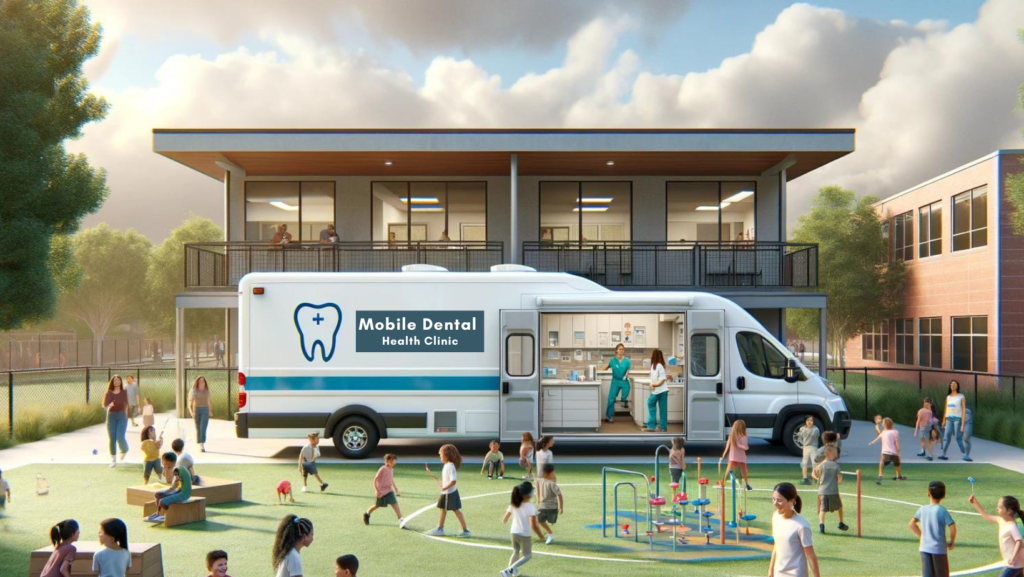School-Based Teledentistry Program Playbook
Technology combined with place-based care addresses barriers that contribute to inequities in oral health outcomes.
Project Description
Virginia Health Catalyst (Catalyst), with funding and support from the Health Resources and Services Administration and the Virginia Department of Health, partnered with community-based dental programs like Federally Qualified Health Centers and their neighborhood schools to develop and implement school-based oral health programs that include teledentistry. These programs combine technology, clinical care, and oral health education to ensure students can access preventive and restorative oral health services while creating enduring connections to a dental and medical home.
Oral health is integral to overall health, and dental disease is the most common childhood disease (more common than asthma), causing pain and infection that contributes to multiple chronic conditions and affects a child’s readiness to learn. According to the most recent surveillance data from the National Health and Nutrition Examination Survey (NHANES), more than half of all children have more than one cavity in their primary teeth. Health disparities rooted in race, income level, disability, and other social identities are pervasive and persistent, making disparities more pronounced when considered by race: Black and Latinx Virginians experience higher rates of tooth decay, tooth loss, and inadequate dental coverage. NHANES also reports that nationally, 33% of Mexican American children and 28% of non-Hispanic Black children aged 2 to 5 have experienced cavities in their primary teeth, in contrast to only 18% of non-Hispanic White children.
The Centers for Disease Control and Prevention provides state-specific oral health data and information about social supports that can improve access to services: https://www.cdc.gov/oral-health/.
Catalyst’s School-Based Teledentistry Program was designed to bring care to students to minimize barriers that lead to persistent inequities. The initiative also incorporates proven solutions to improve consent rates, offers education and training for providers and school nurses to develop efficient and effective workflows and communication channels, and trains school nurses to use intraoral cameras to enable timely communication with health professionals. The result is an efficient and effective program that reduces barriers to care for children and families and serves as an enduring dental and medical home for the student.

Using the School-Based Teledentistry Program Playbook
The playbook content offers a detailed, step-by-step approach to help your school or community health center establish an infrastructure for integrating teledentistry in schools. The community health center and school teams that Catalyst worked alongside required a year and a half of planning to prepare for implementation. This chapter serves as the groundwork for planning your implementation. Stay tuned for the release of chapter two in early 2026, which will guide the implementation process and ensure long-term sustainability.
Virginia Health Catalyst is ensuring that all Virginians have access to comprehensive healthcare, including oral health. Our mission is to eliminate barriers to optimal health by addressing inequities and inefficiencies within the healthcare system. We aim to transform and strengthen the health system and its environment by collaborating with the community and partners, addressing health disparities, and advocating for policies that benefit the most vulnerable populations. Our goal is to create a more equitable healthcare system.
We achieve health equity through a multifaceted approach:
Public Health
We address community, environmental, and social factors to equitably improve oral and overall health.
Policy
We advocate for laws, policies, and regulations at all levels of government that support positive health outcomes and health equity.
Public Awareness
We guide decision-making with research, data, and information that highlight the critical role of oral health in overall health.
Clinical and Community Care
We strive to ensure that care is equitable, high-quality, coordinated, and integrated.
We believe that education, advocacy, and technical support are essential for influencing policy and driving systemic change. By fostering open communication, building strong partnerships, striving for excellence, and respecting communities’ needs and voices, we place equity at the forefront of the healthcare landscape.
Chapter 1
Introduction
Benefits and Challenges of School-Based Teledentistry Programs
Program Models
Preparing for Implementation
Quality Improvement & Program Evaluation
Working with Schools
Catalyst, with the help of partners, staff, leadership, and the Board of Directors, recognizes that oral health and overall health are inextricably linked—yet they are often separate and sometimes undervalued aspects of health care. An interdisciplinary and integrated healthcare approach benefits patients, caregivers, providers, and the entire healthcare system.
To achieve equitable, personal, community-centered, and value-based care for patients through the school-based teledentistry initiative, Catalyst staff works with healthcare teams to establish shared goals, understand the needs of patients and the community they serve, and offer education within and across settings that achieve coordinated, high-quality care.

This project is supported in part by the Health Resources and Services Administration (HRSA) of the U.S. Department of Health and Human Services as part of a Health Resources and Services Administration Oral Health Work Force Grant awarded to the Virginia Department of Health (Project Period 09/01/2022 – 08/31/2026). The contents are those of the author(s) and do not necessarily represent the official views of, nor an endorsement, by HRSA, HHS, or the U.S. Government.